ADDRESS AND INTERACTION WITH THE PARTICIPANTS OF THE INDIA EMPOWERED EVENT NEW DELHI
20-12-2005 : Delhi
Connectivity for empowering the nation
I am indeed delighted to participate in the interactive session of "India Empowered" event. It was a delightful experience for me to study every day from 14 August 2005, the writing on the subject, ?Empowering India? from each one of you have assembled here, that too, with your rich experience in multiple fields. My greetings to the organizing team of Indian Express, the writers on India Empowered series and other participants.
My team studied over 160 articles and grouped them into 12 areas of presentation. I would like to highlight the grouping and its significance.
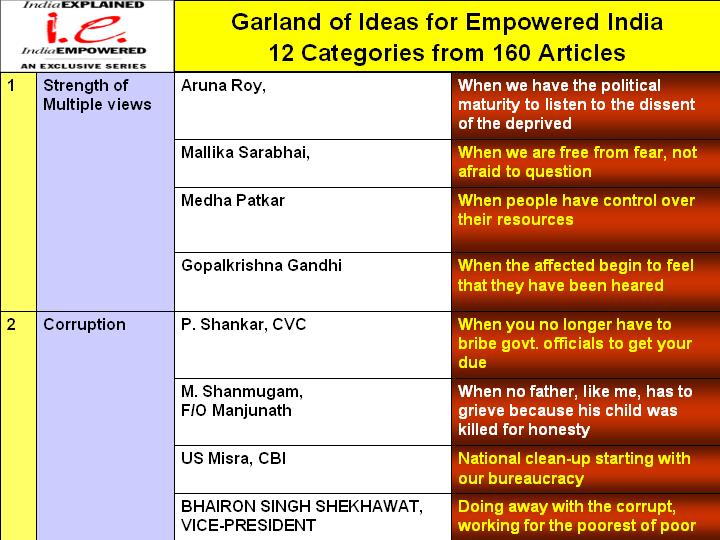
It was indeed thought provoking and looked like a garland of ideas with a purpose of empowering our nation and its people.
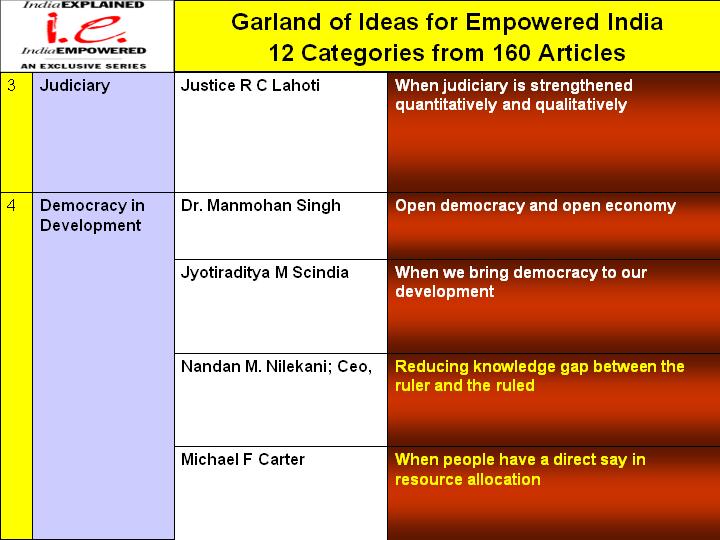
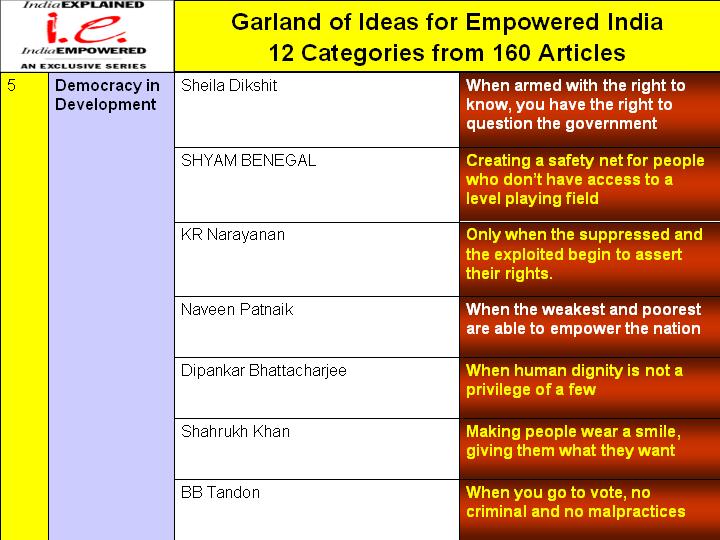
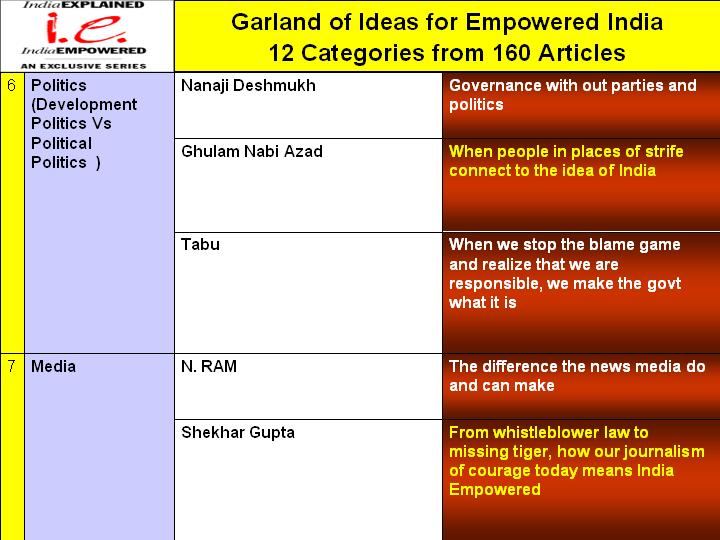
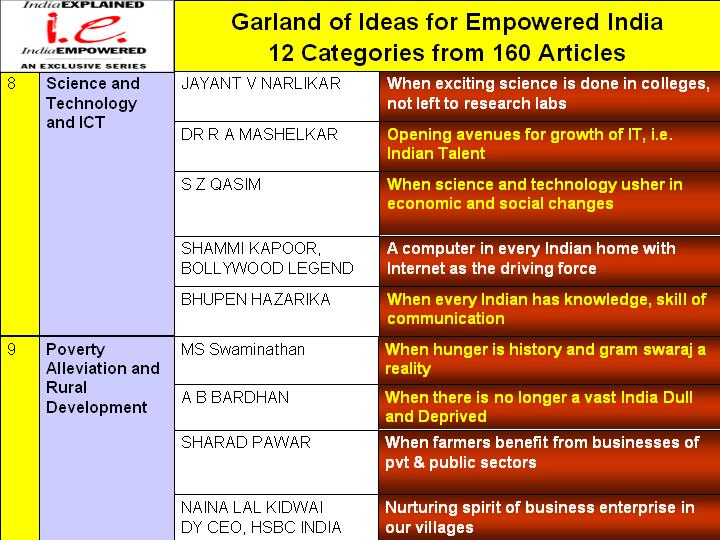
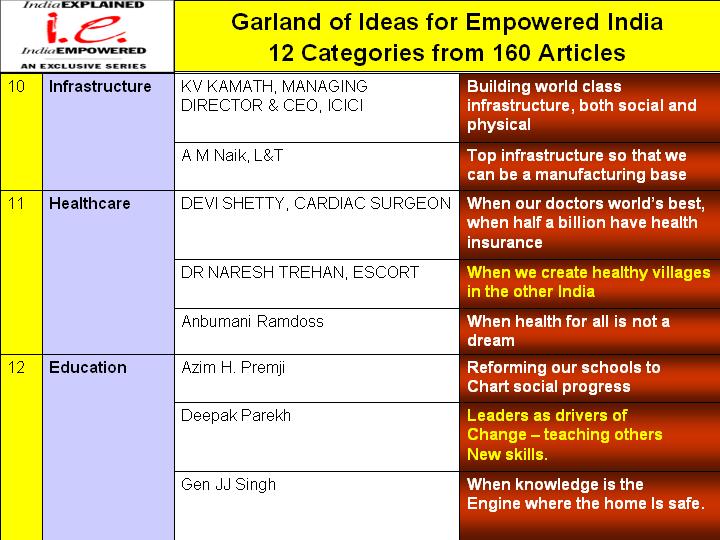
This garland of ideas focuses, as I see, how we need an integrating system for the empowerment of nation and its people. These thoughts lead me to share with you the subject of discussion: "Connectivity for Empowering the nation".
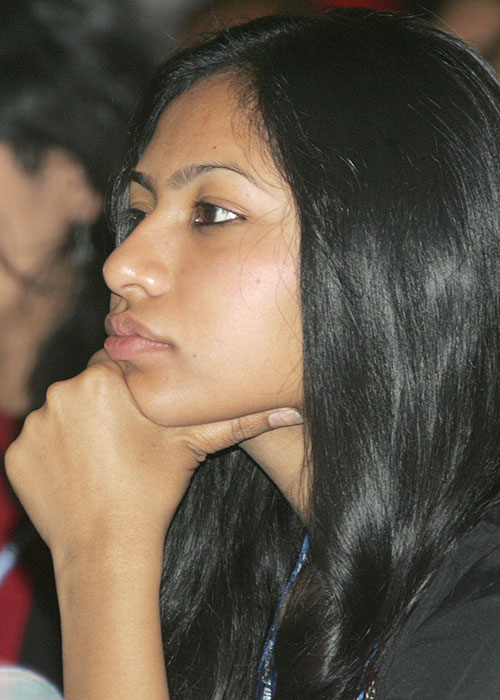

Our resources
The total land area of India is around 3.3 million square kilometer with 7000 kilometers of coast line. The altitude of the country varies from the sea level to 8,600 meters. The entire area is spread into deserts, hilltops, mountains, sea
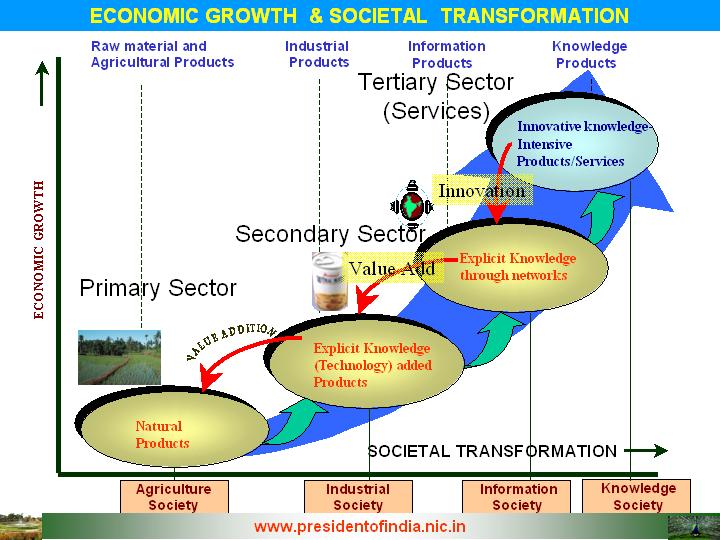
shores, islands, valleys and plains. Out of the billion plus population in the country 70% live in six hundred thousand villages. We need a societal transformation and sustainable development for our growth. These two aspects are realizable in a time bound manner only through a knowledge society, which alone will empower the entire nation. India has the potential to become a knowledge society. Electronic and knowledge connectivity is the key to realize this goal. Connecting a billion people throws up multiple challenges. Now I would like to discuss about societal transformation.
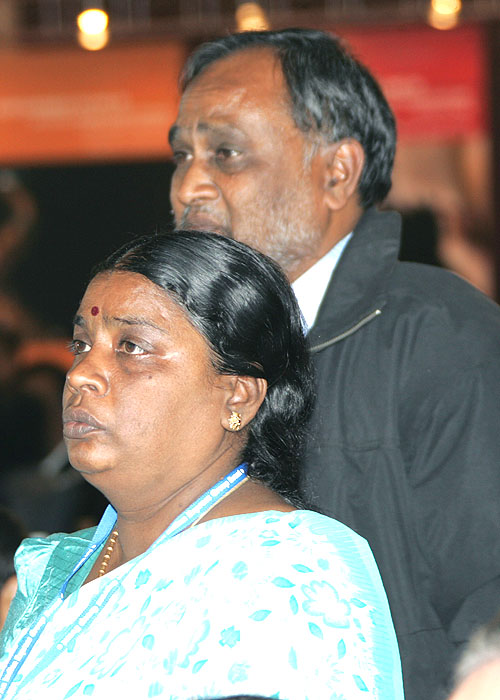

Societal transformation
Societal transformation and economic growth are interlinked. Knowledge Societies enrich information society through innovation. Information society enriches agriculture
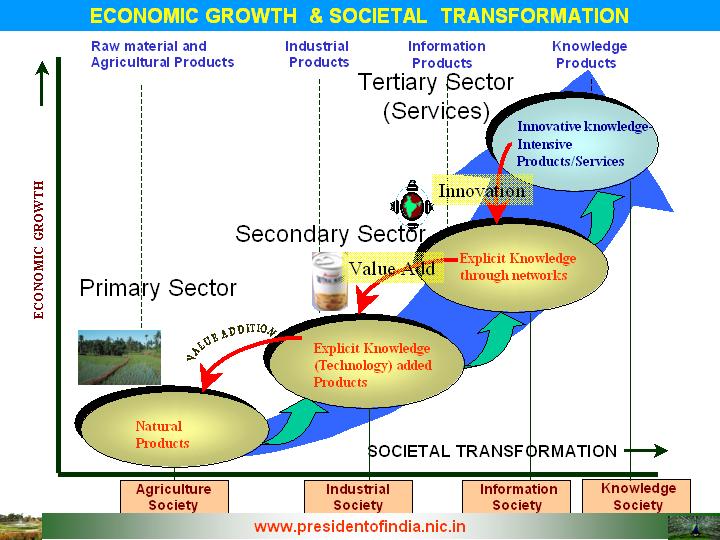
and manufacturing through value addition. The whole purpose of education in a country is to develop and enhance the potential of our human resource and progressively transform it into a knowledge society. The knowledge society will be a society producing products and services that are rich in both explicit and tacit knowledge, thus creating value added products. The real capital of this knowledge society will be its knowledge components. The society will be highly networked
to create knowledge intensive environment along with enabling process to efficiently create, share, use and protect knowledge. Our education system should re-align itself at the earliest to meet the needs of the present day challenges and be fully geared to participate in the societal transformation.
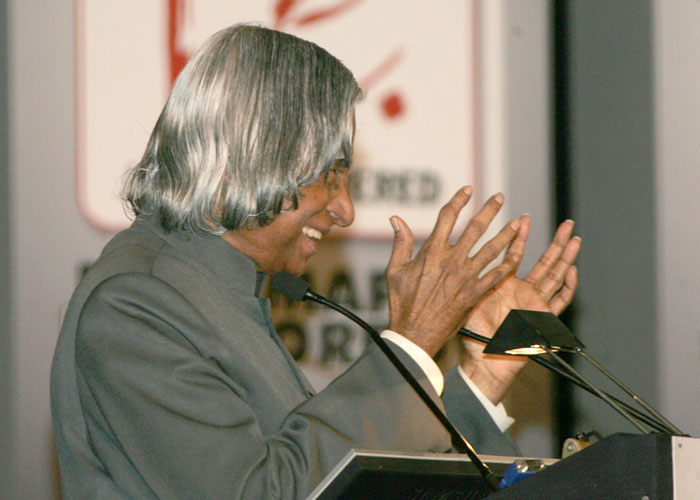

Changing Pattern of Society
When the world was moving from the industrial to information and knowledge era, we witnessed a changing pattern in the sectoral share of GDP and the number of people employed in each sector.
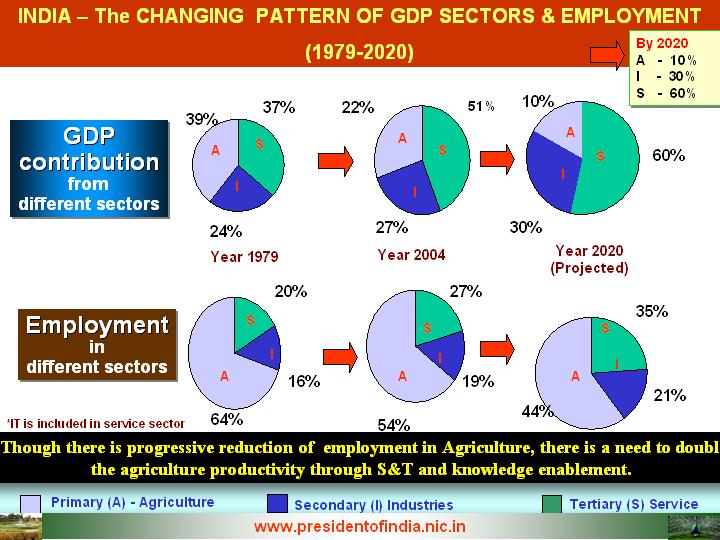
The sectoral share of Gross Domestic Product (GDP) percentage has undergone a change. Contribution of agriculture to India?s GDP has reduced from 39% to 22% during the period 1979 to 2005. During the same period contribution of manufacturing sector has moved from 24% to 27%; whereas the contribution from the services sector has increased from 37% to 51%. There has been considerable change in the employment pattern also. The percentage of people employed in agriculture has come down from 64% to 54%. Simultaneously, the percentage of people employed in manufacturing has gone up from 15% to 19% and in the service sector from 20% to 27%. This trend has to continue and by 2020 our employment pattern should aim at 44% in agriculture, 21% in manufacturing and 35% in service sectors.
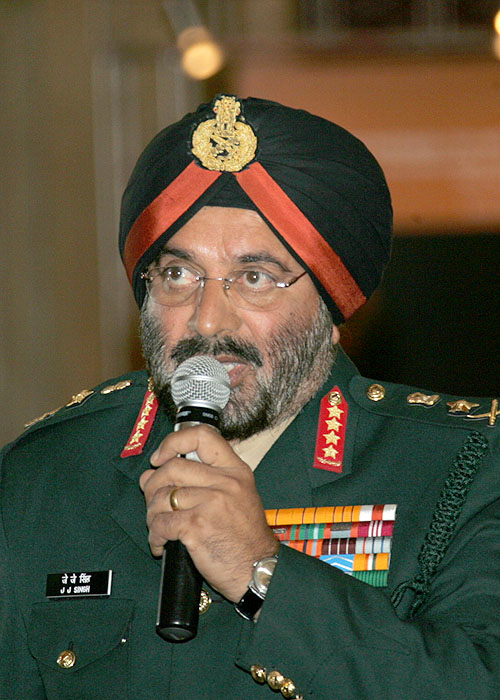
The displacement of 10% people from agriculture sector has to be facilitated through skill enabling for undertaking value added tasks in the rural enterprises so that migration to urban area is reduced. Instead of persons from the rural areas going to urban towns in search of jobs in manufacturing and services sectors, PURA (Providing Urban Amenities in Rural Areas) facilitates creation of employment in the rural areas itself. PURA achieves this by providing physical, electronic and knowledge connectivities to a cluster of villages thereby leading to their economic connectivity and prosperity. Knowledge creation and knowledge utilization is the key to the success of a PURA programme. Now I would like to talk about the characteristics of the Knowledge economy.
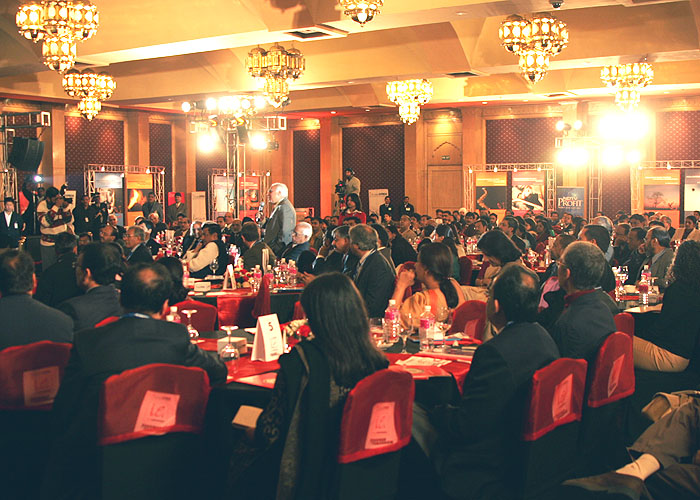

Characteristics of the Knowledge economy
I was studying different dimensions of knowledge society how will it be different from the industrial Economy. In the knowledge economy the objective of a society changes from
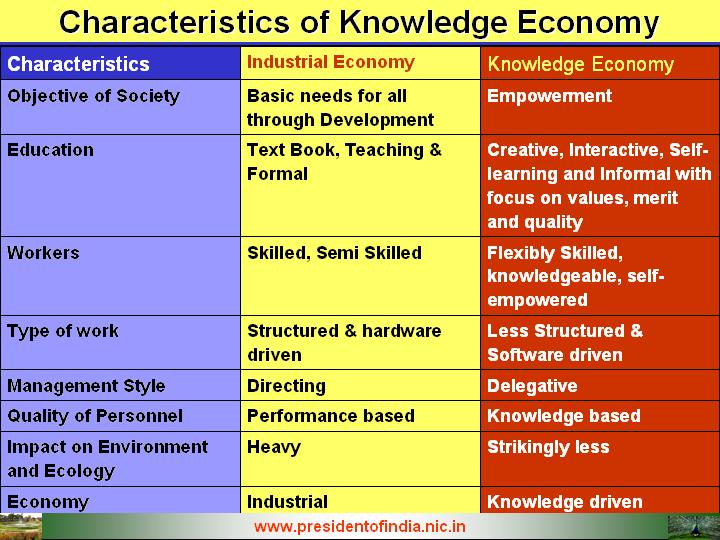
fulfilling the basic needs of all round development to empowerment. The education system instead of going by text book teaching will be promoted by creative, interactive self learning ? formal and informal with focus on values, merit and quality. The workers instead of being skilled or semi-skilled will be knowledgeable, self empowered and flexibly skilled. The type of work instead of being structured and hardware driven will be less structured and software driven.
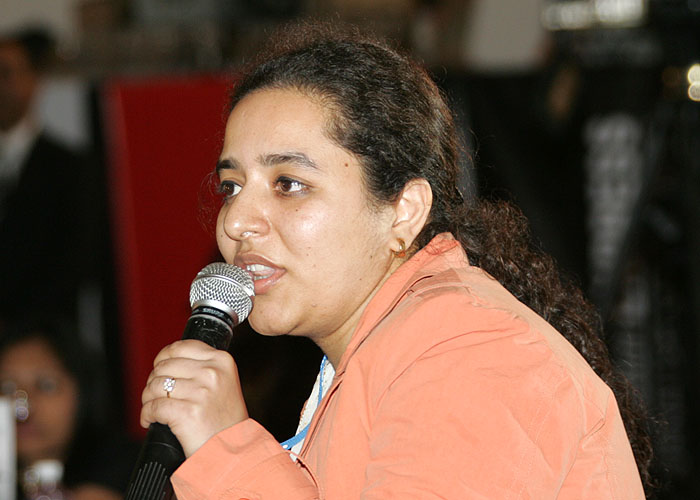
Management style will be delegative rather than being directive. Impact on environment and ecology will be strikingly less compared to industrial economy. Finally, the economy will be knowledge driven.

Empowerment through Connectivity
The core of empowerment for prosperity of one billion people is the connectivity and partnership between
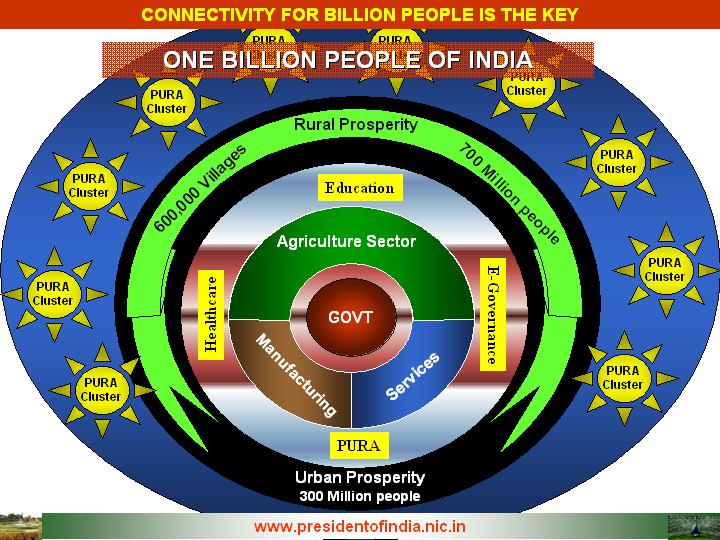
governmental and multiple institutions in the public and private domains. The strength of this partnership for collaborative growth and economic prosperity is facilitated by free flow of knowledge and information in a seamless manner cutting across levels and boundaries embracing all walks of life in the three sectors of the economy such as agriculture, manufacturing and services. These aspects have been effectively brought out by many of the authors of the articles in Indian Express.
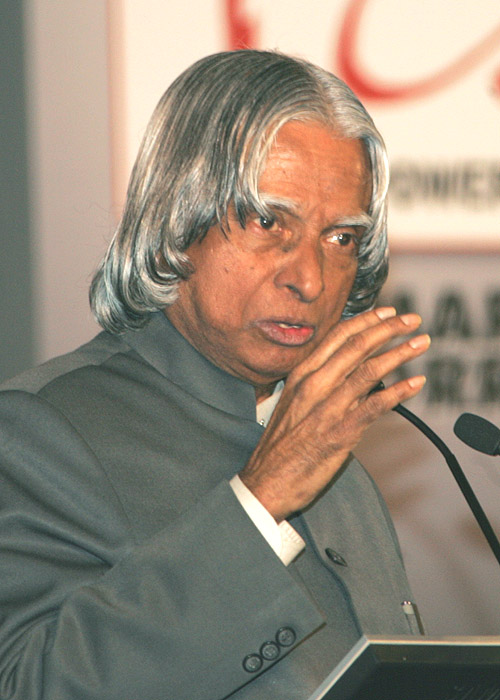
The aim of transformation is to maximize gross domestic production and productivity of the land and people through maximizing the performance of each sector namely, agriculture, manufacturing and services, synergized by the system of inter and intra-sectoral electronic and knowledge connectivity to serve a billion people.
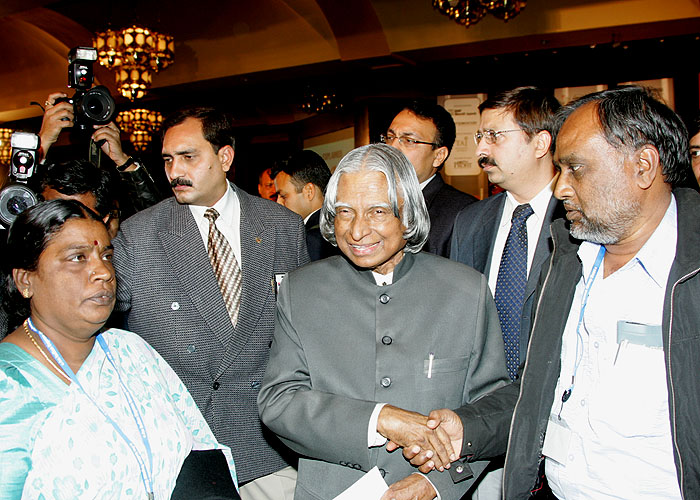
In the proposed model, the inter-connectivity between these three sectors of the economy is brought about by four grids: namely, Knowledge Grid, the Rural (Seven thousand PURA) Grid, Health Grid and the Governance Grid. Each grid is a system of multiple portals. This system of grid will bring prosperity to 700 million people in the rural areas and 300 million plus people in the urban areas. In the process, it will ensure that the lives of 260 million people are transformed from below the poverty line. First let me discuss about knowledge grid.

Knowledge Grid
India is now in the process of creating virtual universities and institutions for knowledge sharing, knowledge
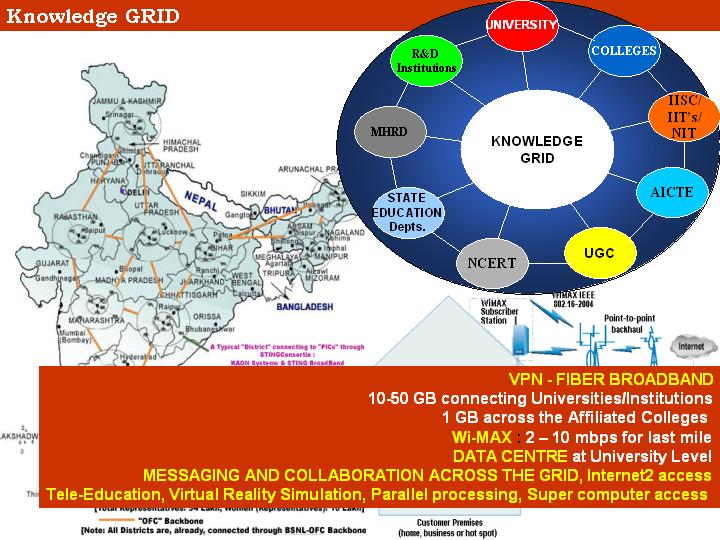
dissemination and knowledge reuse. While it is known that the Virtual Universities provide us with technologies of the future and the most economic way of scaling high quality education in the country, they are no substitute to the campus based education. The challenge before the Virtual Universities is to provide the best of breed of both the worlds. In this process, we could plan an optimum mix of direct contact hours between the students and the teachers and also amongst the students themselves. These interactions should also be used as a platform to excite the students to take to learning in the new paradigm.
In the world of Virtual Universities the equitable access to all its participants is the primary goal. Unlike in the real world, the equitable access is always the democratic average, in the Virtual Universities the equitable access always means the equitable access to the best resources ? be it the teachers, be it the library, be it the laboratory, available across the network. In effect, the network brings the best of its participants to every one of its participants. The three phases of learning are the lectures, library and laboratories. They require increasing bandwidth from a few 100?s of kilobytes for the lectures to a few megabytes for the formal digital libraries and the informal world of knowledge from the Internet, to gigabits of connectivity for remote laboratories in the world of high precision science and engineering. As the bandwidth becomes cheaper and available in abundance, universities should be able to run remote instruments and facilities as complex as NMR to Wind tunnels. These are applications that can make a difference in how we engage in teaching, learning, and research in higher education.
This will ultimately provide equitable access to the entire education system beyond just the lectures and the lecturers. Thus the bandwidth is the demolisher of imbalances and a great leveler in the knowledge society. We have rich knowledge institutions but what we have to add is connectivity. This connectivity today is technologically possible but would need creation of high band width reliable network infrastructure to the extent of minimum 10 Gigabits per second all through the country to provide uniform access of
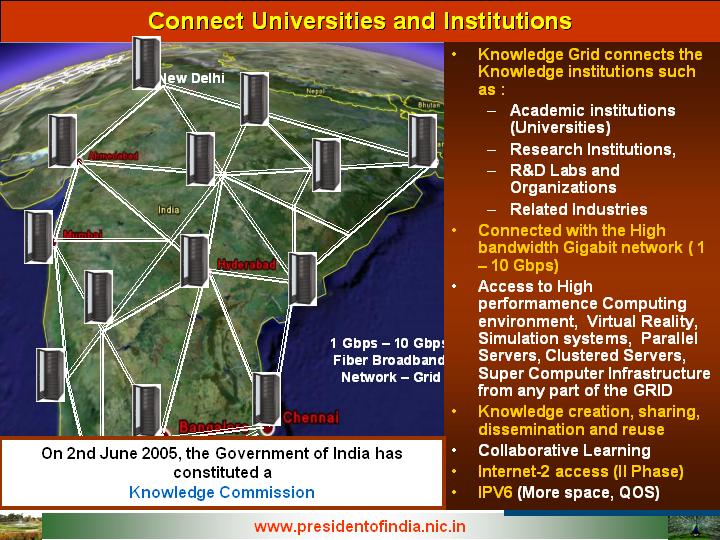
knowledge in different regions leading to the creation of Knowledge GRID.
ERNET in the Educational and Research Network of India connecting 1500 institutions for internet and intra connectivity for email and other collaboration. Presently ERNET is connecting around 45 institutions across the country in a high bandwidth network with 100 mbps connectivity under the GARUDA project. This will become the part of the proposed Knowledge GRID.
So far I have discussed with you knowledge institutions. Now I would like to discuss on establishing the next network in the system of GRIDs across the country, namely, Health Grid.

Health Grid
Indian Space Research Organization through their INSAT network has connected 25 major hospitals in the mainland. From there they are providing telemedicine connectivity to remote areas including our islands. Rashtrapati Bhavan Clinic is also connected to the CARE Hospitals Hyderabad through telemedicine facility. Also there are a number of public and private initiatives, such as AIIMS, Apollo, Narayana Hridayalaya, Sankara Nethralaya, Aravind Hospitals. There are exclusive tele-medicine etc. The mission of telemedicine with multiple grid is gaining momentum and it will spread to all the equipped Primary Health Centres in the country, medical colleges and research institutions in due course.
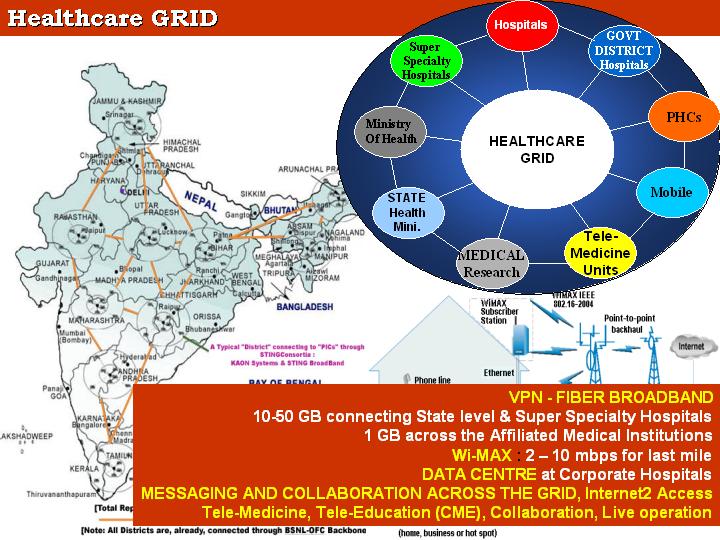
We need to establish a Health GRID, connecting the various health care institutions with regard to the super speciality and general medicine areas. Also healthcare training institutes, such as, nurses, para-medical staff and doctors and the medical research institutions networked to health grid. This will enable unique case studies and experiences to be exchanged between the super specialists through this health grid. It will also be possible to conduct Conferences of specialist doctors from multi centres to discuss
the critical disease patterns and provide treatment. Now I would like to take up e-Governance Grid.

E-Governance Grid
Let me first describe my personal experience in setting up and operating a typical e-Governance Portal established at Rashtrapati Bhavan. Rashtrapati Bhavan has introduced
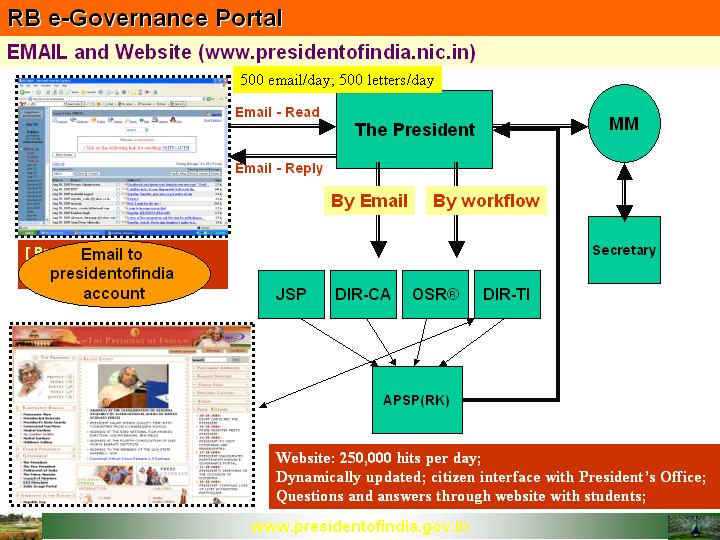
connectivity with our citizens, institutions, universities, government departments and multi-lateral agencies during the last three years.
For enabling such connectivity, all the important events in which the President participates are brought out in the website ( ) as soon as the functions are over. Today, on an average, this website has a hit rate of over two hundred and fifty thousand per day. On certain special occasion like Independence Day, Republic Day, it touches nearly a million hits. In addition, I receive over 500 e-mails and 500 letters on an average from various people from all over the country and abroad. I also receive 100?s of questions from the students and children every day. We have
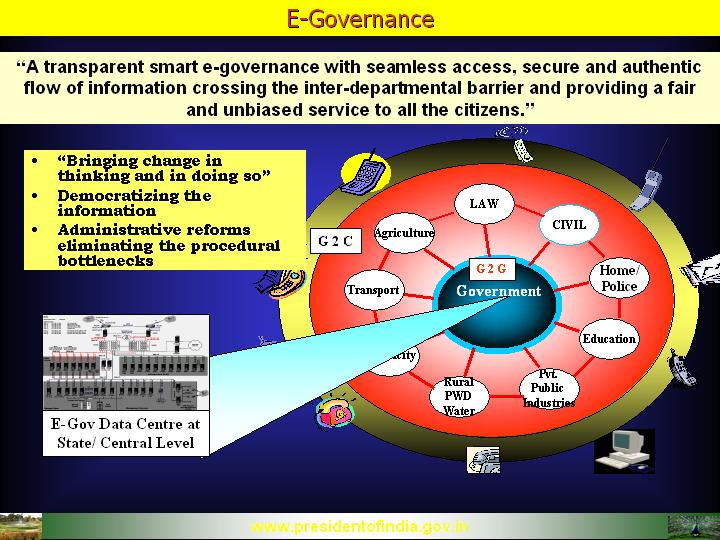
built in an e-Governance system to study all the correspondence on a day to day basis, analyze, prioritize, verify and determine the action requirements to be taken by Rashtrapati Bhavan and other agencies of government and the relevant institutions both public and private. We have now established a less paper dynamic and secured workflow system for the file movements. We have a Fiber broad band POP (Point of Presence) which can connect up to 64 Mbps. We have established within Rashtrapati Bhavan facilities for G2G and G2C connectivity and we are in the process of establishing the high bandwidth broadband VPN connectivity with Central and State Governments and other relevant institutions for seamless flow of information within the existing systems and procedures of Governmental functioning. This will soon become the part of the e-Governance GRID.
Connectivity and Collaboration at RB: Apart from this we have had interactive collaborative conference with number of institutions in India and abroad. The typical among these are:
a. Interactive sessions with engineering students of Punjab colleges through VSAT and Leased Line.
b. IGNOU connectivity to 100 locations through EDUSAT. So far we have connected 40 locations.
c. Inauguration of Virtual University of Madras, Calcutta and Mumbai Universities with Anna University, Madurai Kamaraj Universities, 40 learning centres of IGNOU. Where I took the inaugural class through EDUSAT, tele-education delivery system and the multimedia studio at Rashtrapati Bhavan using PowerPoint presentation for over 15,000 students and answered over 20 questions, referred my talk from the website, referred some pages from two books from RB digital library, drawn the GSLV and Payload in the smart board. A virtual class room has been created during my one and a half hour interaction. The EDUSAT provided the necessary connectivity for the tasks.
d. Interaction with the Carnegie Mellon University, Pittsburg, USA for Digital Library conference through Internet, three inaugural addresses through video conference with US institutions.
e. PAN African Network ? a Tele-Education Delivery system presentation to 28 African Union ambassadors through EDUSAT and Wi-MAX connectivity using the tele-education studio at RB.
f. 25 national and international conferences in India through VSAT, ISDN with interactive sessions with educationists, teachers, space scientists, doctors, business communities through NASSCOM, judiciary and science writers.
g. Interaction with Amrita Village Resources Centres and Kerala schools through EDUSAT, Loni Village connectivity through RF in Maharashtra.
h. Interaction with Periyar PURA and MSSRF Village knowledge centres.
During these interactive discussions and conferences, I have used all the available electronic connectivities through VSAT, EDUSAT, and Leased lines, ISDN, Internet and Wi-MAX. Presently all these connectivities are fully established at Rashtrapati Bhavan and are highly effective. With the last three years of experience, I realize that promote effective, quality and actionable communication; we have to use multi-media comprehensively. This will be determined by the bandwidth availability.
No country has so far implemented an e-governance system for one billion people. It is a big challenge before us. Let us take an example into clarify the connectivity challenges of the country.

Connectivity for E-Governance
Good governance is being recognized as an important goal by many countries across the world. They have taken up specific initiatives for open government. Freedom of information is being redefined and supported by detailed guidelines. The internet revolution has proved to be a powerful tool for good governance initiatives. An important dimension of the internet potential is the possibility of providing services any time anywhere. Along with this there is a conscious effort to put the citizen as the centre of focus of the governance. Citizens are being perceived as customers and clients. E-governance has to be citizen friendly. Delivery of services to citizens is considered as a primary function of the government. Particularly in a democratic nation of a billion people like India, e-Governance should enable seamless access to information and seamless flow of information across the state and central government in the federal setup.
Typical scenario: I visualize an election scenario, where a candidate files his nomination from a particular constituency. Immediately the election officer verifies his/her authenticity from the national citizen ID database through multifactor authentication, through a multipurpose Citizen ID card.
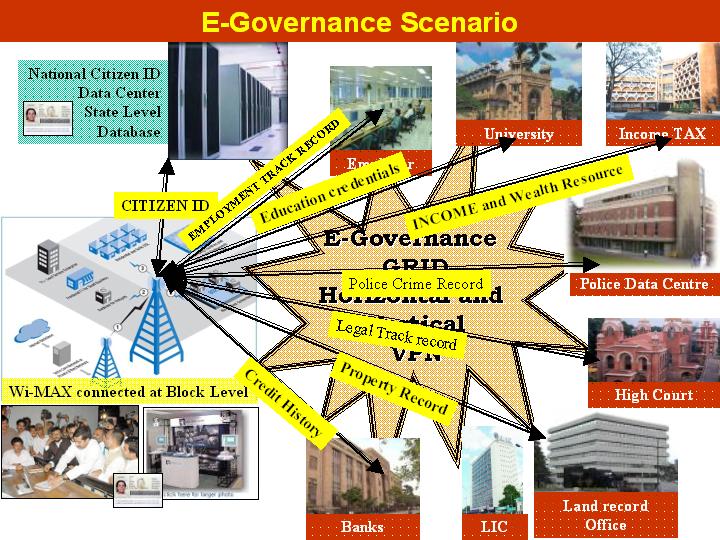
His education credentials come from the university records. His track record of employment comes from various employers with whom he had worked. His income and wealth resources come from the income-tax department, and other sources. His property record comes from the registration of land authority across the country. His credit history comes form various credit institutions like banks. His/her civic consciousness and citizenship behaviour comes from the police crime record. His legal track records come from the judicial system.
All the details arrive at the computer terminal of the election officer within few seconds automatically by the act of e-Governance software agents which crawls across the various state and central government web services directories through the network GRID and collects the information automatically and presents the facts in real-time with out any bias. Artificial intelligence software analyses his credentials and gives a rating on how successful he will be as a politician. Election officer sitting at the remote block of the country decides on the spot and the election process starts. All the voters vote from their home through virtual polling booths. Is it a dream? Is it possible? If possible, when shall we have it? Can we provide good governance to our one billion people? Can the governance speed up the delivery system? Can the governance differentiate between genuine transactions and spurious transaction? Can the governance ensure immediate action for the genuine cases which satisfies the check list for a particular service and pend the action on spurious transactions? Can this be done by e-governance at a cost affordable by our nation? If we have this system implemented then I can call this as a true e-Governance system for the citizen.
NICNET in India is providing connectivity to Government organizations using 2-8 mbps connectivity. It also has a internet data centre with 80 terra bytes of storage and more than 150 servers connected for the missions such as election data and event oriented projects for the government organizations.
To establish a system what I have visualized, we need a high bandwidth broadband connectivity across the many Government departments such as State and District Administration, Election commission, Universities, Banks,
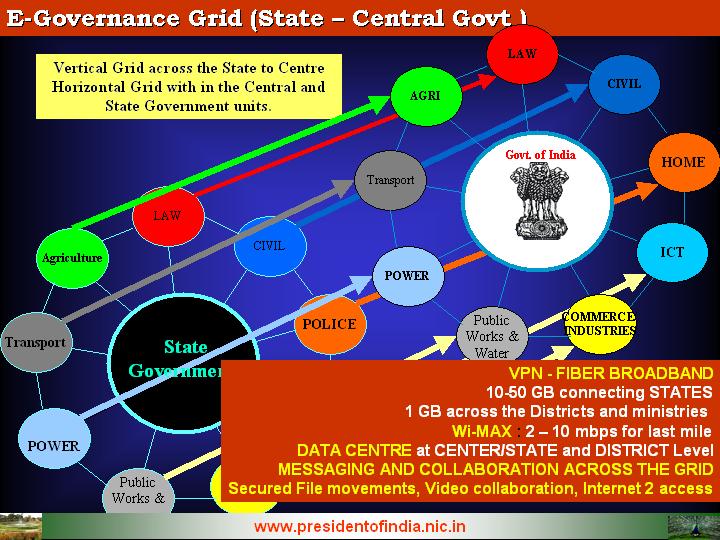
Home/Police Departments, Insurance companies etc., This scenario requires vertical and horizontal grid established across various institutions. Hence, we can draw information and feed information from these GRIDs for seamless flow of data to achieve the goal of good governance.

Characteristics of the Rural (Seven thousand PURA) Grid
For providing the knowledge connectivity to the PURA complexes, Village Knowledge Centers will act as frontline delivery system. I visualize establishment of village knowledge center in the Village Panchayat to empower the villagers with the knowledge and to act as a local center for knowledge connectivity for the villagers within the overall framework of PURA.
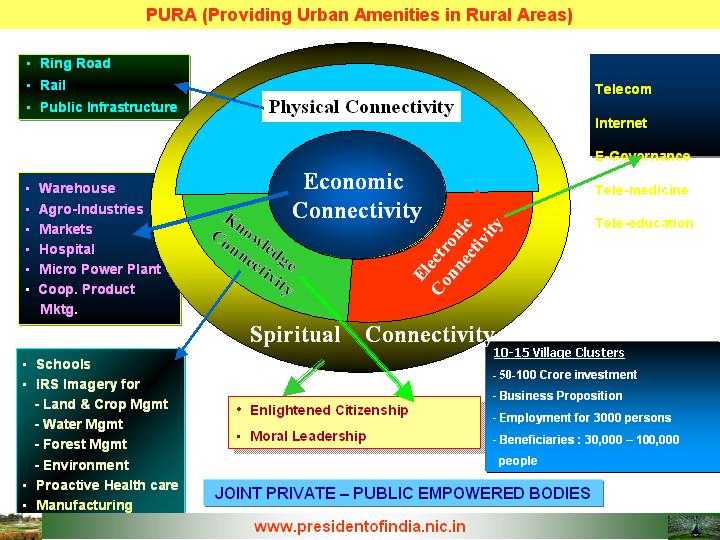
VKC: The Village Knowledge Centre should provide the essential data required for the targeted population such as farmers, fishermen, craftsmen, traders, businessmen, entrepreneurs, unemployed youth and the students. It has to be acquired by visiting the village, talking to the rural people, by understanding their requirement and core competence. Providing meteorological data for both farmers and fishermen has to be area specific, covering say 20 or 30 villages in the vicinity of sea coast or in the farming area. Local relevance of information offered is essential. Users have simple needs of information but often it is a tough problem for system integrators because of the need of updation of data. Trained manpower with experience have to be deployed to generate information which can explain to the people in simple terms the meteorological data, weather data, marketing data on fish, agricultural and other rural commodities. These data have to come from various connected institutions which provide the service to the people on a timely basis periodically. But the transformation of data into user friendly information on a regular updated basis is the real challenge. The main focus of the Village Knowledge Centre should be to empower the youth to undertake development tasks of the villages and establish the rural enterprises which will provide large scale employment to the youth of the village. So, it is essential to skill enable and knowledge enable through the Academic institutions, industry, banking and marketing institutions. VKC should act as a facilitator. Blended knowledge is a better knowledge.
Infrastructure and Connectivity: A low cost multi-task handheld computer with GPS and wireless mobility should be developed by the private industries and organizations and should reach the fishermen and farmers in different parts of the country. They should add value to this tool for their benefit to increase their earning capacity. Village Knowledge Centre should have a computer terminal, wireless (Wi-Max) connections or fiber broadband or satellite connectivity to connect to the Nodal Centers for acquisition of knowledge and dissemination of updated real time data.

PURA Nodal Knowledge Data Centre
Ministry of Agriculture has established Kisan Call Centre which provides valuable and timely knowledge support to the
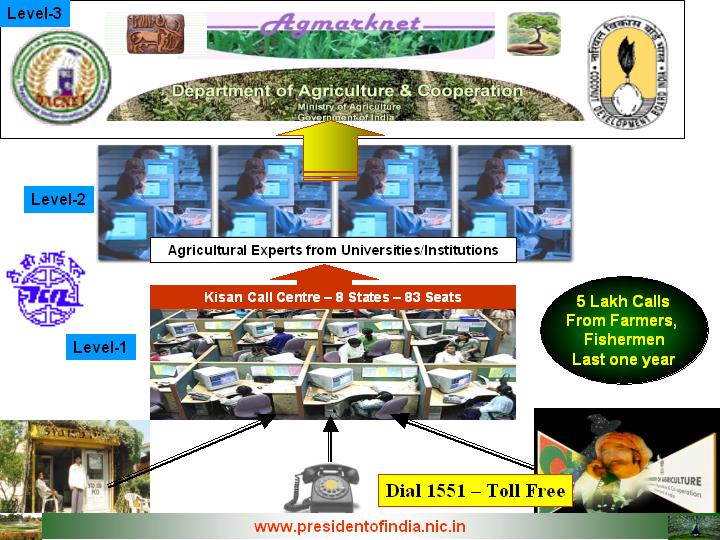
farmers and fishermen. Similar Domain Service Provider Call centers are required in the field of Commerce and Industry, Entrepreneurial skill Development and employment generation, Travel and Tourism, Banking and Insurance, Meteorological forecasting, Disaster Warning systems, Education and Human Resource Development and Health care.
These call centers will act as a service provider to the PURA Nodal Knowledge Data Centers located in the PURA Complexes, which in turn will provide the area specific and customized knowledge to the Village Knowledge Centers in the villages in a holistic manner. This delivery will depend on the availability of robust connectivity to different parts of the country. This forms the PURA GRIDs which draws information from the other GRIDS and will act as a catalyst for the societal transformation in the rural areas.
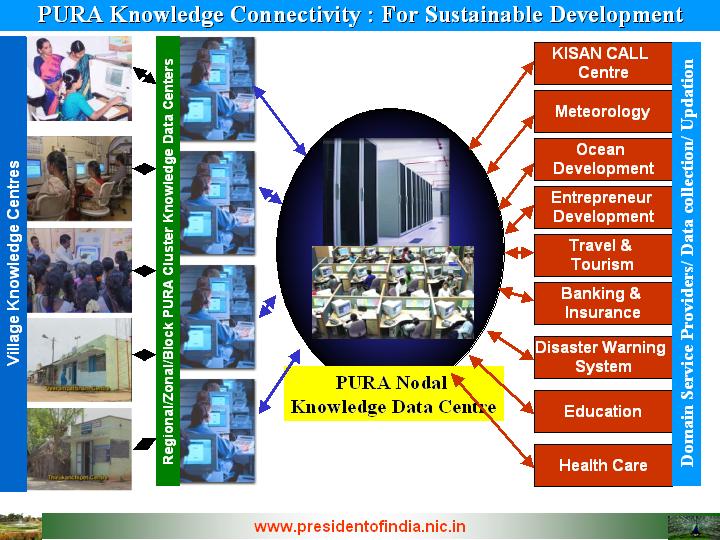
So far I have discussed with you on the necessity for establishing various GRIDs by citing examples on how connectivity is important one in e-Governance and the other with knowledge institutions. Now I would like to discuss on how to connect all the GRIDs across the country to fulfill the mission objective of entering into a knowledge society.
Connectivities: Societal GRID
So far we have discussed the connectivities within the various proposed grids, that is, intra-grid connectivities. However, to maximize the synergy between the grids, leading to maximization of GDP and productivity, there is need for inter-grid connectivities, which may be called as Societal Grid.
knowledge sharing, knowledge utilization and knowledge re-use is very vital by all constituents of the society for promoting non-linear growth. Societal Grid consists of:
1. Knowledge GRID - Inter connecting universities with socio-economic institutions, industries and R&D organizations.
2. Health Care GRID - Inter-connecting the Health Care institutions of Government, Corporate and Super specialty hospitals. Research institutions, educational institutions and ultimately, Pharma R & D institutions.
3. E-Governance GRID - Inter-connecting the Central Government and State Governments and District and Block level offices for G2G and G2C connectivity.
4. PURA Knowledge GRID ? Connecting the PURA Nodal centers with the Village knowledge centres and Domain service providers. Since this is the backbone for rural development, all other GRIDs will infuse the knowledge into this GRID for sustainable development, healthcare and good governance. For example, five of the Periyar PURA villages have now connected using Wi-MAX connectivity. Integrated Village knowledge centers will act as an inter-connected delivery mechanism for tele-education tele-medicine and e-Governance services apart from individual access by the people, within and between the Village Knowledge Centres through the PURA Grid.
We have so far discussed all the four connectivities required for the societal transformation. These connectivities can form the basis for providing platform for societal transformation leading to empowerment. This will blossom with the enabling environment of trust and confidence in the overall system.
Trust and confidence in Governance
Many of the authors who have written on "Empowering India" have shown their concern on the issue of trust and confidence. Definitely together we can find a solution. As a part of governance, the Government needs to provide multiple facilities and services to the people. Also, these services are required to be constantly upgraded with the use of technology for fulfilling the aspirations of the people. The Government budgets and expends a large amount of funds for fulfilling this goal. The money for the work comes from people through taxes. It is the money collected from the people, which is being spent for the benefit of all the people and particularly the needy. The expenditure incurred on the projects and programmes should lead to maximizing the benefits to large number of people, as visualized. This is applicable to all the services such as, education, healthcare, sanitation, water, power, road, drainage, tele-communication, seeking of loans from the banks for agriculture and small-scale industries and many other areas of societal importance.
Conclusion
As we are talking about the responsibilities of the Government, it is also essential, that people are equally responsible. Education system has to create responsible enlightened citizens. A great society is interwoven by fast responsive elected government and also righteous citizens. In this connection, I would like to recall a hymn that brings out the righteous righteousness in the heart is fundamental to the transformation to the peaceful society.
Righteousness
Where there is righteousness in the heart
There is beauty in the character.
When there is beauty in the character,
There is harmony in the home.
When there is harmony in the home.
There is an order in the nation.
When there is order in the nation,
There is peace in the world.
It is a beautiful connectivity between heart, character, nation and the world. In a society we have to build righteousness among all its constituents. For the society as a whole to be righteous we need creation of righteousness in family, righteousness in education, righteousness in service, righteousness in career, righteousness in business & industry, righteousness in civil administration, righteousness in politics, righteousness in government, righteousness in law and order, righteousness in justice. In addition to righteousness in multiple dimensions in the society, indomitable spirit is essential for realizing the vision of developed India.
I am sure, participants of the India Empowered event will discuss and lead to action agenda for creation of an empowered nation. My best wishes to all of you in your creative mission.
May God bless you.
<<Back
|